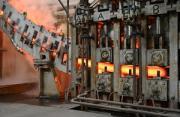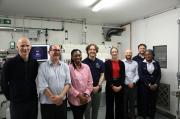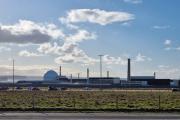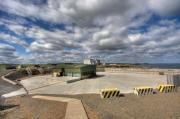
This site uses cookies, by continuing to use this site you accept the terms of our privacy policy
Feed 2.0 Loading...
Dounreay Director Sets Out Benefits Of Programme Acceleration
25th June 2006
A workforce that can safely deliver the decommissioning and demolition of Britain's fast reactor experiment at Dounreay is a workforce that will be in demand worldwide for its skills.
This is the message delivered today by Norman Harrison, director of UKAEA Dounreay, in a new publication setting out the benefits of accelerated clean-up of the site and the efforts being made to find alternative employment for staff whose jobs presently depend on this work.
UKAEA has put forward proposals to the Nuclear Decommissioning Authority to accelerate the completion of the clean-up from 2036 to 2033 and, together with its business partners AMEC and CH2MHILL, is looking to advance this further.
Teams of staff are looking at ways to bring forward key dates for completion of the major decommissioning milestones, including emptying of the shaft and silo, clean-out of the Dounreay Fast Reactor and treatment of liquid wastes left over from historical reprocessing. On current plans, employment is predicted to decline from 2012 onwards.
At the same time, a working group formed by community and business leaders is consulting on a draft strategy for economic regeneration of Caithness and north Sutherland.
The eight-page document being issued to staff at Dounreay sets out how acceleration of the work can maintain higher levels of employment in the short-term and bring significant environmental and safety benefits by getting wastes into a safe condition for long-term storage or disposal at the earliest opportunity,
It also lists 31 redundant buildings and structures due for demolition, in addition to 14 cleared last year, as the decommissioning and demolition work moves forward at pace.
In his introduction, Norman Harrison says: "Take one look around the Dounreay site today and no-one can be in any doubt that we mean what we say about accelerated decommissioning. In every corner of the site, redundant facilities are being cleaned out, old facilities pulled down and new buildings being constructed to manage the wastes.
"Dounreay is coming apart. My priority, everyone's priority, is to ensure it comes apart in a way that is safe, secure and environmentally acceptable. And in so doing, we give ourselves the best possible chance of attracting the new jobs we need to succeed decommissioning. A workforce that is recognised worldwide for its achievement in knocking down Dounreay is a workforce that will be in demand."
Dounreay - Delivering for the Nuclear Decommissioning Authority describes how there are overwhelming safety, security and environmental reasons for cleaning out and knocking down the redundant facilities as quickly as it is safe to do so. But it also shows how bringing forward work to achieve this can maintain employment levels at a higher level in the short-term.
It also unlocks funds that otherwise would be spent on maintaining redundant facilities for long periods of time, and these funds can be recycled in a number of ways. They can be used to bring forward other work, or they can be used to support initiatives to create alternative employment. Some of these funds are already being invested in new enterprises with the potential to create new and sustainable economic development.
Dounreay was Britain's centre of fast reactor research and development from 1954 until 1994. It is now being decommissioned by UKAEA, with support from AMEC and CH2MHILL, on behalf of the Nuclear Decommissioning Authority.
Approximately 2000 people are employed on the Dounreay site, working for more than 50 companies. This accounts for one in every five jobs in the local economy. Decommissioning is worth an estimated �70-80 million per annum to the local economy.
A copy of Dounreay - Delivering for the Nuclear Decommissioning Authority can be viewed on the UKAEA website at
Delivering For the Nuclear Decommissioning
Related Businesses
Related Articles
10/1/2025
Fusion-grade Steel Produced At Scale In UK-first
Researchers achieve 10x production cost savings for reduced activation steel. A United Kingdom Atomic Energy Authority (UKAEA) working group has successfully demonstrated the industrial scale production of fusion-grade steel.
22/12/2024
UKAEA To Lead The Creation Of A Robotics And AI Cluster
UKAEA will lead the creation of a new £4.9m nuclear robotics and artificial intelligence cluster across Cumbria and Oxfordshire. The robotics and AI cluster was announced by UK Research and Innovation (UKRI) as one of seven new projects to kickstart economic growth and address regional needs: www.ukri.org The robotics and AI cluster will link Cumbria and Oxfordshire to accelerate the decommissioning of the UK's legacy nuclear fission facilities and keep people out of hazardous environments.
5/12/2024
Diamonds Are Forever? World-first Carbon-14 Diamond Battery Made In Uk
The world's first carbon-14 diamond has been produced with the potential to provide power for thousands of years. Scientists and engineers from the UK Atomic Energy Authority (UKAEA) and the University of Bristol have successfully created the world's first carbon-14 diamond battery.
4/11/2024
UKAEA Monthly Newsletter Latest Edition
Find out what has been happening at UKAEA in our monthly newsletter. Read about our recent activities and upcoming events.
1/10/2024
UKAEA Newsletter - Edition 11 Published Today
Find out what has been happening at UKAEA in our monthly newsletter. Read about our recent activities and upcoming events.
23/5/2024
Corwm Visits Dounreay Nuclear Site
Members were given an overview of the scale of the problem and challenges faced in the decommissioning of the site. In the last week of March 2024, several members of CoRWM led by the Chair, Sir Nigel Thrift, made the long journey up to the North of Scotland to visit the Dounreay nuclear site, now managed by Nuclear Restoration Services.
5/3/2021
Design Contract Awarded For Dounreay Shaft And Silo Work
Dounreay has awarded an important waste clean-up contract to Jacobs as the site plans for the future of its deepest historic radioactive waste store. Jacobs and its supporting partners have been awarded a 6-year contract to provide a design management team to produce a fully integrated design for the shaft and silo project.
6/11/2013
Radiation dose to public from Dounreay reduces
Dounreay�s radioactive impact on the environment continues to fall, according to a report. The annual survey report �Radioactivity in Food and the Environment� (RIFE 2012) has recently been published and it can be read here - http://www.sepa.org.uk/radioactive_substances/publications/rife_reports.aspx The report uses data obtained from samples of air, fresh water, grass, soil, and locally sourced meat, fish, milk and vegetables during 2012.
6/4/2012
57,000 Tonnes Of Hazardous Materials Finally Dealt With At Dounreay
Dounreay today completed the destruction of one of the most hazardous legacies of Britain's earliest atomic research. A purpose-built chemical plant processed the last of 57,000 litres of liquid metal lifted from the primary cooling circuit of the experimental fast breeder reactor.24/3/2011



